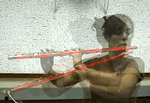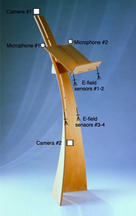Interactive Digital Multimedia
IGERT Summer Projects
| Out of the Ether Redux |
||||||||||
Students Bo Bell, Music Jim Kleban, Elec & Comp Engineering Dan Overholt, Media Arts & Tech Lance Putnam, Media Arts & Tech John Thompson, Postdoctoral Researcher
|
Faculty Advisors
|
|||||||||
Abstract The use of computers in the arts is now wide spread.
In music, the computer is a powerful instrument for performing real-time
synthesis and transformation processes. However, many input devices
used to interface with computers are designed for office-like work
and not musical performance. The problem then arises: how does an
expert musical performer apply their existing technique naturally
to performance with a computer? Previous attempts involve sensor
augmentation of traditional instruments, creating entirely new instruments,
playing along with fixed computer accompaniment, and using external
controls such as foot pedals. All of these solutions, however, force
the musician to adopt new performance responsibilities sometimes
with an obtrusive or constraining effect. Our approach is to use
audio, video, and electric field sensors to more naturally inform
the cueing and control of computer-generated musical material in
the context of live performance. We hope to make the technology
transparent to the audience while freeing the performer from the
use of knobs and switches often used in musical human-computer interaction.
In addition to providing a transparent manner of interacting with
the computer performer, this system should open many musical possibilities
to the musical performer and composer. We intend to examine mapping
strategies for the gestural control of multimedia content using
this system. An overarching theme in this examination is the mapping
of gesture across sound and image.
|
|
|||||||||

